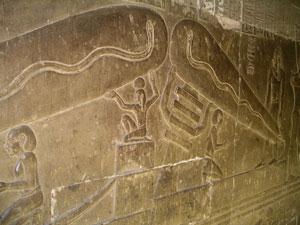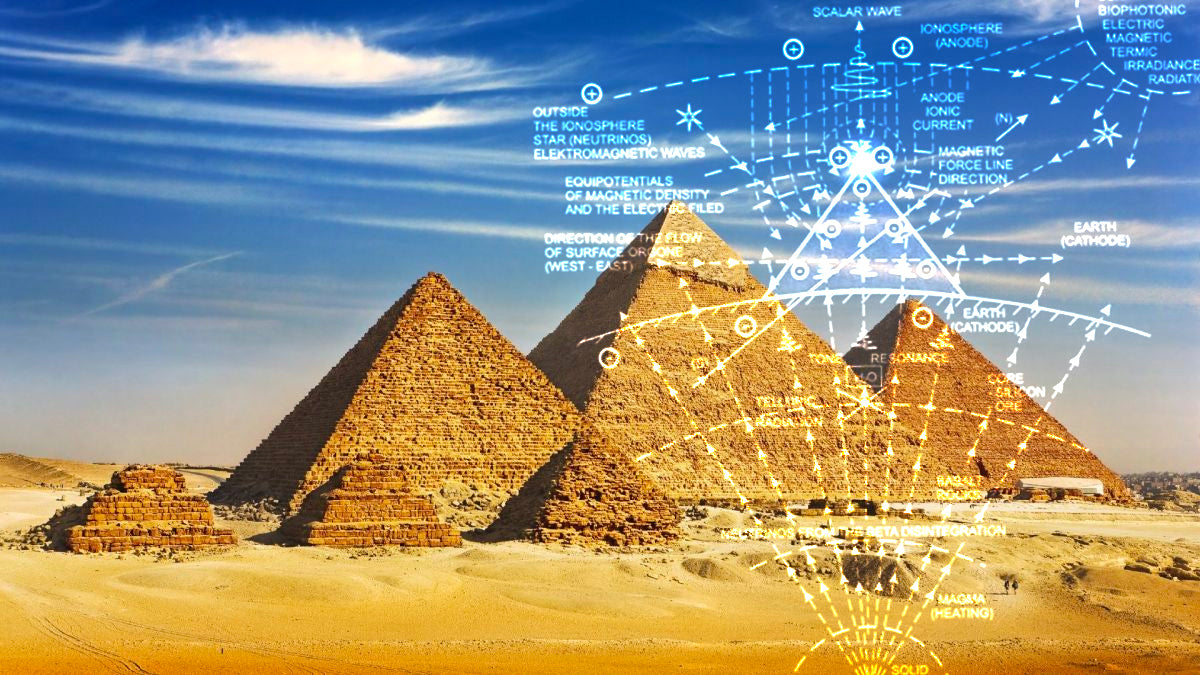This article was originally published by ijert.org
The Overall Science Behind the Pyramid
K.S.Vishwanath Vashisht Assistant Professor, Department of Aerospace Engineering, Amity University, Manesar, Gurgaon, Haryana, India.
Abstract- The main objective of this study is to predict the possibility of electrical power generation, transmission and distribution from the massive pyramids of the world. The information includes on the geometric details and importance, alignment and its importance, pyramids as a storage place for mummies?, ionization process, working of pyramids, materials used for construction, molecular structure observations in plant tissues, animals and humans, and science behind the generation of electricity. The comments are also made on the successful pyramid construction made possible by ancient people who were connected in a global scale with same technology on the entire planet. Keywords- Pyramid, Electrical power, crystal, electromagnetic field, negative ions, giant humans.
I. INTRODUCTION The pyramids constructed on earth dates back to at least 3000 BC. These amazing gigantic structures were constructed on only those locations by the people of ancient civilizations where the electromagnetic charges are found to be maximum on the surface of the globe. The pyramids and their ruins on the globe can be located in Egypt, China, Mexico, Unites States of America, Turkey, Indonesia, France, Canary islands, Italy, Mauritius, Bosnia, Iran, Sudan, Iraq and Cambodia. The remains of pyramids indicates that the people in that time were experts in Electrical, Mechanical, Biological, Metallurgy, Astronomical, Astrological, Architectural, Physical and Chemical sciences. The figure below shows the pyramid structures of the world.







- Negative Ions help to reproduce and repair body cells. They're transmitted into the body through the air and are circulated by the blood. Too many positive ions (the result of air pollution) can cause depression, and ultimately, illnesses. Thus, negative ions have a beneficial effect on the body. Pyramids generate negative ions. In addition, they are believed to have a generally balancing effect on the body's electromagnetic field. This effect is greatly enhanced if the materials used is gold or copper.
- Restores the luster of tarnished jewelry and coins. Also sharpness and strength to the sword.
- Purify water.
- Mummify
- Help keep milk fresh and prevent souring without refrigeration.
- Dehydrate flowers without losing their form or color.
- Increase the growth rate of plants.
- Help attain increased relaxation.
- Improves the taste of coffee, wine, and certain fruit juices.
- Promotes healing of cuts, bruises and burns, as well as reduces pain from toothaches and headaches.
- Many people have also experienced that after sleeping inside a pyramid they find that they need less sleep and feel more relaxed and at peace when they wake up.
- Egyptologists have found well preserved grain in tombs that is thousands of years old. In contrast, grains stored in modern world to store grains near the field, usually spoils after only a few seasons of storage. Grain in modern silos usually keeps no longer than four years.
- The animal apparently wandered into the King's Chamber and perished before finding an exit route at the pyramid of Giza. The cat's body dried out, although the air in the King's Chamber is always humid.
- In accordance with funerary customs, an elaborate meal was set out on pottery platters. The meal consisted of porridge, quail, kidneys, pigeon, fish, beef ribs, triangular loaves of bread, cakes and fruits. Their state of preservation was so excellent that Egyptologists easily recognized all of the foods in the entire meal, although it is almost 5,000 years old.
- Meditating inside a pyramid: Feeling of warmness, a sense of weightlessness, tranquility, relaxation, enhanced focusing, a positive approach can be observed in a user who regularly uses a pyramid
Looking into the above points, there is a possibility that they also experimented with genetics and microbiology. Since small experimental pyramids are capable of multiplying the plants cells faster, massive sized pyramids should also increase the growth of animals and plants abruptly. [15]It suggests that experiments on infants, their needs, growth measurements could have been done inside. This leads to the questions on the possibilities of the presence of giant humans, because the pyramid in Giza is constructed by many giant limestone weighing 15 tonnes of excellent fineness and precision. And the construction upto the apex of the pyramid requires skilled labour, machinery and tools. From the cave paintings and carvings, one can give the hierarchical meanings of importance or can conclude that the giants existed at one point of time due to experiments done inside the pyramids who could easily handle 15 tonnes of limestone rocks as well as machineries. The figure below shows the servants applying water on a giant human, 2 normal sized humans serving a giant human, servants with giant humans on the boat with normal sized humans and skeleton structures obtained in the Egypt with diggers.




The figure below shows the technology of flying machines from the rock carvings from the caves. It is evident that very few flying machines can be identified by us are aircraft, helicopter and space station and we do not have answers for the other carvings yet. This shows the advance in their technology and machineries.

[1] Fitchen, “Building Cheops’ Pyramid” – Journal of the Society of
Architectural Historians, Vol. 37, No. 1, Mar., 1978, pp. 3-12
[2] Isler, “On Pyramid Building” (Part 1) – Journal of the American
Research Center in Egypt, Vol. 22, 1985, pp. 129-142
[3] Isler, “On Pyramid Building” (Part 2) – Journal of the American
Research Center in Egypt, Vol. 24, 1987, pp. 95-112
[4] Lally, “Engineering a Pyramid” – Journal of the American
Research Center in Egypt, Vol. 26, 1989, pp. 207-218.
[5] Isler, “Egyptian Methods of Raising Weights” – Journal of the
American Research Center in Egypt, Vol. 13, 1976, pp. 31-42
[6] Isler, “An Ancient Method of Finding and Extending Direction”
– Journal of the American Research Center in Egypt, Vol. 26,
1989, pp. 191-206.
[7] Bárta, M. (2005) ‘Location of the Old Kingdom Pyramids in
Egypt’, Cambridge Archaeological Journal, 15(2), pp. 177–191.
doi: 10.1017/S0959774305000090.
[8] Brichieri-Colombi, Stephen. 2015. Engineering a Feasible Ramp
for the Great Pyramid of Giza. – Palarch’s Journal of
Archaeology of Egypt/Egyptology 12(1), 2015, 1-16. ISSN
1567-214X
[9] El-Sabban, S. 2000: The Cat’s Coffi n of DHwtyms in the Cairo
Museum. – Discussions in Egyptology 46: 65-78.
[10] Veldmeijer, André J. 2011. Studies of Ancient Egyptian
Footwear. Technological Aspects. Part XIV. Leather Eared
Sandals. – Palarch’s Journal of Archaeology of
Egypt/Egyptology 8(5) , 2011, 1-31. ISSN 1567-214X
[11] James, P, The Rise and Demise of Egypt’s Largest pyramids: A
builders View. – Structure Magazine April 2014 (online at:
http:// www.structuremag.org/?p=1860).
[12] Stocks. D, Experiments in Egyptian Archaeology. – London &
New York, Routledge, 2003.
[13] Verner, M, The Pyramids: The Mystery, Culture, and Science of
Egypt’s Great Monuments. – New York, Grove Press, 2002.
[14] Vyse, R.W. Operations Carried on at the Pyramids of Gizeh in
1837. – London, Weale & Nikkison, 1840.
[15] Zakrzewski, S.R., Variation in Ancient Egyptian Stature and
Body Proportions. – American Journal of Physical
Anthropology 121: 219-229. Submitted: 4 December 2014
Published: 16 April 2015
[16] X-Rays Analysis and X-Rays Diffraction of casing stones
from the pyramids of Egypt, and the limestone of the
associated quarries., Davidovits J., Science in Egyptology;
A.R. David ed.; 1986; Proceedings of the “Science in
Egyptology Symposia”; Manchester University Press, UK;
pp.511- 520.
[17] Igor Túnyi and Ibrahim A. El-hemaly, Paleomagnetic
investigation of the Great Egyptian Pyramids, Europhysics
News, 43/6, 28-31, 2012.
[18] Barsoum M.W., Ganguly A. and Hug G., J. Am. Ceram.,
Microstructural Evidence of Reconstituted Limestone
Blocks in the Great Pyramids of Egypt, Soc. 89[12], 3788-
3796, 2006.
[19] Daresbury, SRS, The Enigma of the Construction of the Giza
Pyramids Solved?, Scientific British Laboratory,
Synchrotron Radiation Source, 2004.




